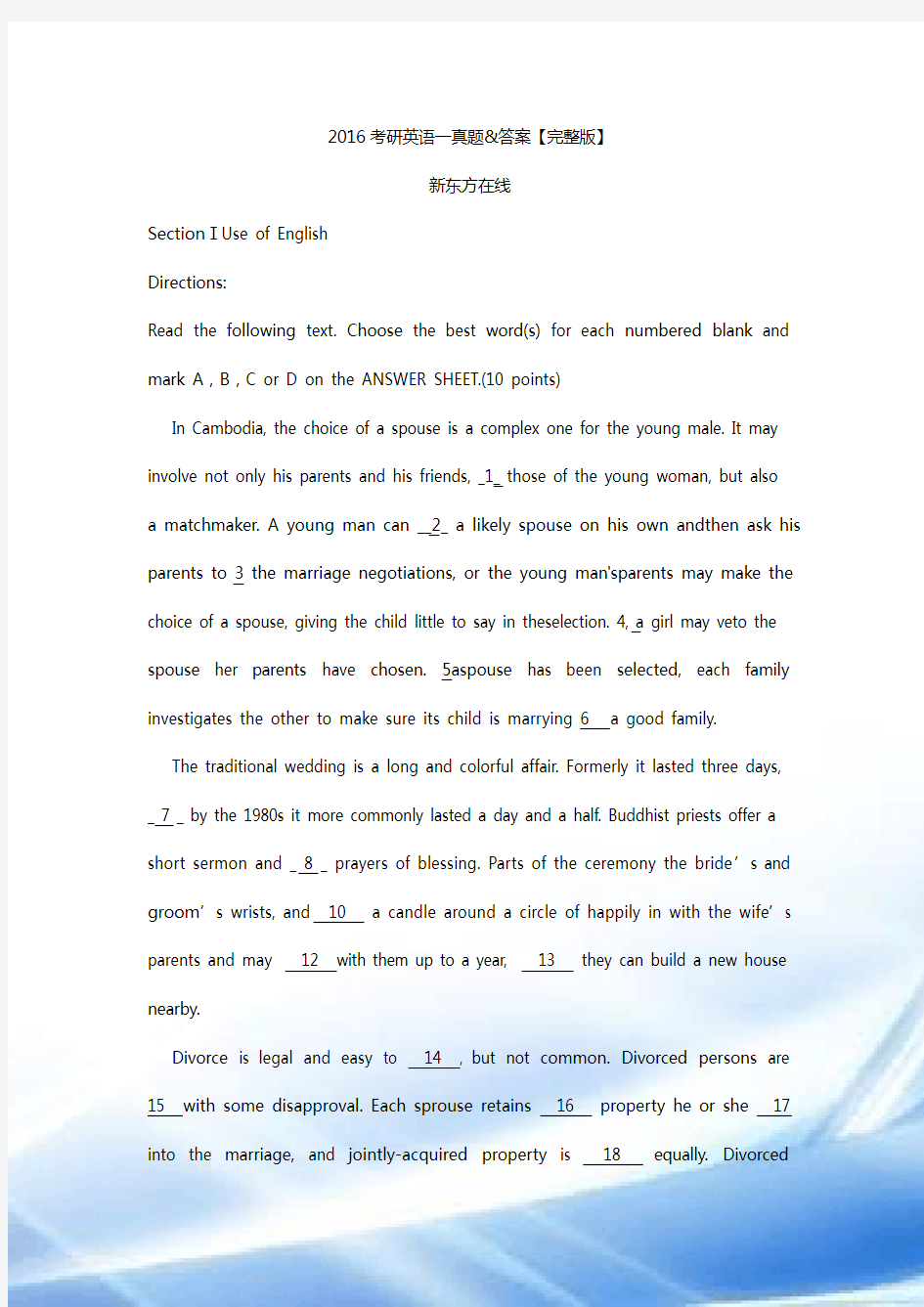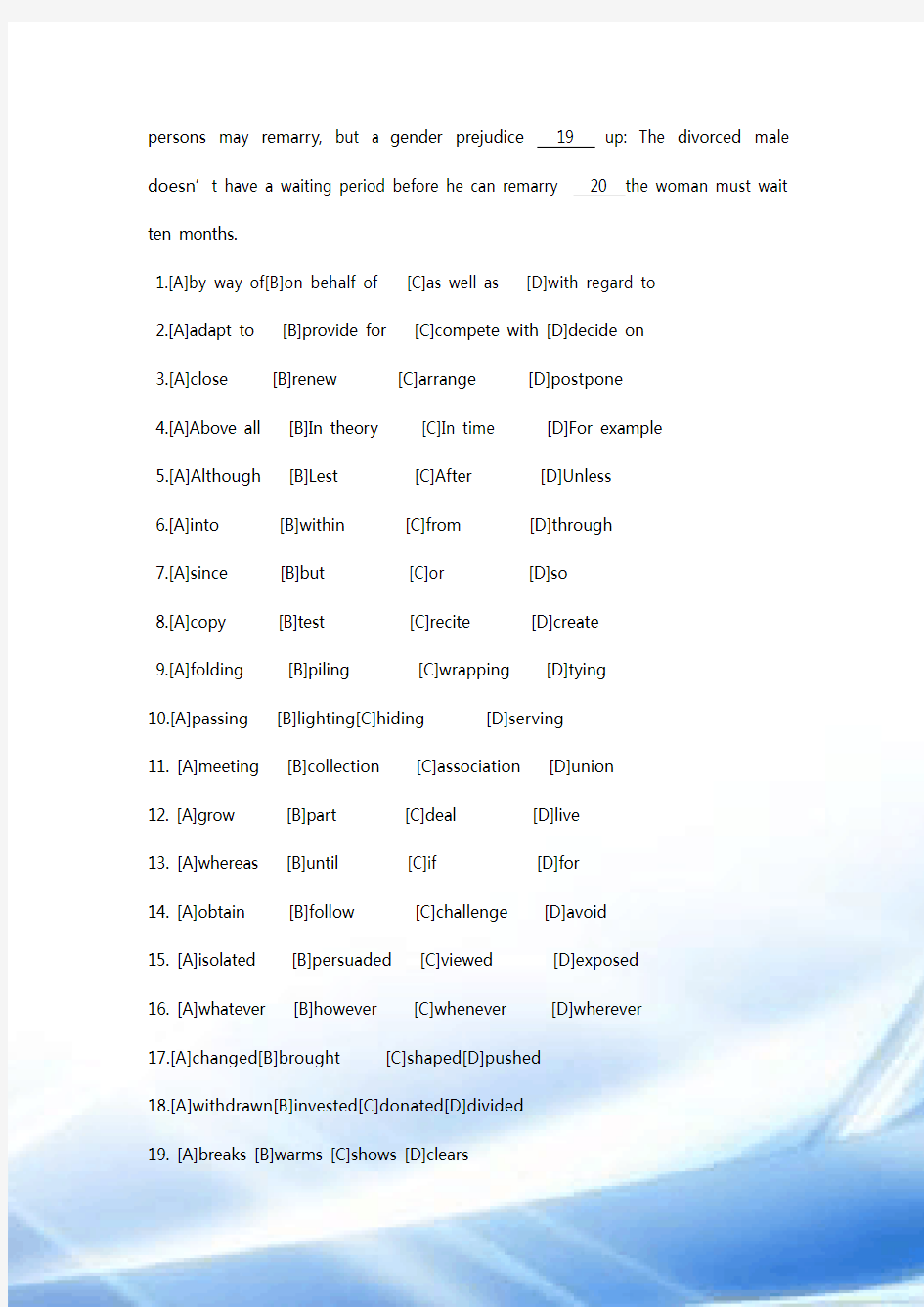2016考研英语一真题及答案(word版)


2016考研英语一真题&答案【完整版】
新东方在线
SectionⅠUse of English
Directions:
Read the following text. Choose the best word(s) for each numbered blank and mark A,B,C or D on the ANSWER SHEET.(10 points)
In Cambodia, the choice of a spouse is a complex one for the young male. It may involve not only his parents and his friends, _1_ those of the young woman, but also a matchmaker. A young man can __2_ a likely spouse on his own andthen ask his parents to 3 the marriage negotiations, or the young man'sparents may make the choice of a spouse, giving the child little to say in theselection. 4, a girl may veto the spouse her parents have chosen. 5aspouse has been selected, each family investigates the other to make sure its child is marrying 6 a good family.
The traditional wedding is a long and colorful affair. Formerly it lasted three days, _ 7 _ by the 1980s it more commonly lasted a day and a half. Buddhist priests offer a short sermon and _ 8 _ prayers of blessing. Parts of the ceremony the bride’s and groom’s wrists, and 10 a candle around a circle of happily in with the wife’s parents and may 12 with them up to a year, 13 they can build a new house nearby.
Divorce is legal and easy to 14 , but not common. Divorced persons are 15 with some disapproval. Each sprouse retains 16 property he or she 17 into the marriage, and jointly-acquired property is 18 equally. Divorced
persons may remarry, but a gender prejudice 19 up: The divorced male doesn’t have a waiting period before he can remarry 20 the woman must wait ten months.
1.[A]by way of[B]on behalf of [C]as well as [D]with regard to
2.[A]adapt to [B]provide for [C]compete with [D]decide on
3.[A]close [B]renew [C]arrange [D]postpone
4.[A]Above all [B]In theory [C]In time [D]For example
5.[A]Although [B]Lest [C]After [D]Unless
6.[A]into [B]within [C]from [D]through
7.[A]since [B]but [C]or [D]so
8.[A]copy [B]test [C]recite [D]create
9.[A]folding [B]piling [C]wrapping [D]tying
10.[A]passing [B]lighting[C]hiding [D]serving
11. [A]meeting [B]collection [C]association [D]union
12. [A]grow [B]part [C]deal [D]live
13. [A]whereas [B]until [C]if [D]for
14. [A]obtain [B]follow [C]challenge [D]avoid
15. [A]isolated [B]persuaded [C]viewed [D]exposed
16. [A]whatever [B]however [C]whenever [D]wherever
17.[A]changed[B]brought [C]shaped[D]pushed
18.[A]withdrawn[B]invested[C]donated[D]divided
19. [A]breaks [B]warms [C]shows [D]clears
20.[A]so [B]while [C]once [D]in that
Text 1
France, which prides itself as the global innovator of fashion, has decided its fashion industry has lost an absolute right to define physical beauty for women. Its lawmakers gave preliminary approval last week to a law that would make it a crime to employ ultra-thin models on runaways. The parliament also agreed to ban websites that “incite excessive thinness”by promoting extreme dieting.
Such measures have a couple of uplifting motives. They suggest beauty should not be defined by looks that end up impinging on health. That’s a start. And the ban on ultra-thin models seems to go beyond protecting models from starving themselves to death-as some have done. It tells the fashion industry that it must take responsibility for the signal it sends women, especially teenage girls, about the social tape-measure they must use to determine their individual worth.
The bans, if fully enforced,would suggest to women (and many men) that they should not let others be arbiters of their beauty. And perhaps faintly,they hint that people should look to intangible qualities like character and intellect rather than dieting their way to size zero or wasp-waist physiques.
The French measures, however, rely too much on severe punishment to change a culture that still regards beauty as skin-deep-and bone-showing. Under the law, using a fashion model that does not meet a government-defined index of body mass could result in a $85,000 fine and six months in prison.
The fashion industry knows it has an inherent problem in focusing on material
adornment and idealized body types. In Denmark, the United States, and a few other countries, it is trying to set voluntary standards for models and fashion images that rely more on peer pressure for enforcement.
In contrast to France’s actions, Denmark’s fashion industry agreed last month on rules and sanctions regarding the age, health, and other characteristics of models. The newly revised Danish Fashion Ethical Charter clearly states: “We are aware of and take responsibility for the impact the fashion industry has on body ideals, especially on young people.”The charter’s main tool of enforcement is to deny access for designers and modeling agencies to Copenhagen Fashion Week (CFW), which is run by the Danish Fashion Institute. But in general it relies on a name-and-shame method of compliance.
Relying on ethical persuasion rather than law to address the misuse of body ideals may be the best step. Even better would be to help elevate notions of beauty beyond the material standards of a particular industry.
21. According to the first paragraph, what would happen in France?
[A]New runways would be constructed.
[B]Physical beauty would be redefined.
[C]Websites about dieting would thrive.
[D]The fashion industry would decline.
22. The phrase “impinging on”(Line2, Para.2) is closest in meaning to
[A]heightening the value of.
[B]indicating the state of.
[C]losing faith in.
[D]doing harm to.
23. Which of the following is true of the fashion industry?
[A]New standards are being set in Denmark.
[B]The French measures have already failed.
[C]Models are no longer under peer pressure.
[D]Its inherent problems are getting worse.
24. A designer is most likely to be rejected by CFW for
[A]pursuing perfect physical conditions.
[B]caring too much about models’character.
[C]showing little concern for health factors.
[D]setting a high age threshold for models.
25. Which of the following may be the best title of the text?
[A]A Challenge to the Fashion Industry’s Body Ideals
[B]A Dilemma for the Starving Models in France
[C]Just Another Round of Struggle for Beauty
[D]The Great Threats to the Fashion Industry
Text 2
For the first time in history more people live in towns than in the country. In Britain this has had a curious result. While polls show Britons rate “the countryside”alongside the royal family, Shakespeare and the National Health Service (NHS) as what makes them proudest of their country, this has limited
political support.
A century ago Octavia Hill launched the National Trust not to rescue stylish houses but to save “the beauty of natural places for everyone forever.”It was specifically to provide city dwellers with spaces for leisure where they could experience “a refreshing air.”Hill’s pressures later led to the creation of national parks and green belts. They don’t make countryside any more, and every year concrete consumes more of it. It needs constant guardianship.
At the next election none of the big parties seem likely to endorse this sentiment. The Conservatives’planning reform explicitly gives rural development priority over conservation, even authorizing“off-plan”building where local people might object. The concept of sustainable development has been defined as profitable. Labour likewise wants to discontinue local planning where councils oppose development. The Liberal Democrats are silent. Only Ukip, sensing its chance, has sided with those pleading for a more considered approach to using green land. Its Campaign to Protect Rural England struck terror into many local Conservative parties.
The sensible place to build new houses, factories and offices is where people are, in cities and towns where infrastructure is in place. The London agents StirlingAckroyd recently identified enough sites for half a million houses in the London area alone, with no intrusion on green belt. What is true of London is even truer of the provinces.
The idea that “housing crisis”equals “concreted meadows”is pure lobby talk.
The issue is not the need for more houses but, as always, where to put them. Under lobby pressure, George Osborne favours rural new-build against urban renovation and renewal. He favours out-of-town shopping sites against high streets. This is not a free market but a biased one. Rural towns and villages have grown and will always grow. They do so best where building sticks to their edges and respects their character. We do not ruin urban conservation areas. Why ruin rural ones? Development should be planned, not let rip. After the Netherlands, Britain is Europe’s most crowded country. Half a century of town and country planning has enabled it to retain an enviable rural coherence, while still permitting low-density urban living. There is no doubt of the alternative—the corrupted landscapes of southern Portugal, Spain or Ireland. Avoiding this rather than promoting it should unite the left and right of the political spectrum.
26. Britain’s public sentiment about the countryside____
[A]didn’tstart till the Shakespearean age.
[B]has brought much benefit to the NHS.
[C]is fully backed by the royal family.
[D]is not well reflected in politics.
27. According to Paragraph 2, the achievements of the National Trust are now being____
[A]gradually destroyed.
[B]effectively reinforced.
[C]largely overshadowed.
